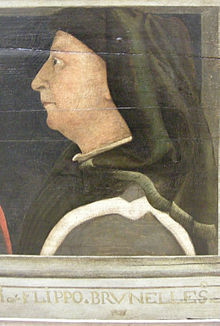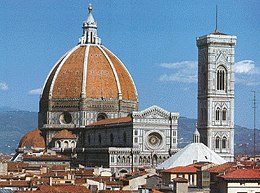
Back Brunelleschi Afrikaans Filippo Brunelleschi AN فيليبو برونليسكي Arabic Filippo Brunelleski Azerbaijani Філіпа Брунелескі Byelorussian Філіпа Брунэлескі BE-X-OLD Филипо Брунелески Bulgarian Filippo Brunelleschi Bislama Filippo Brunelleschi BS Filippo Brunelleschi Catalan
Filippo Brunelleschi | |
|---|---|
 Anonymous portrait from the 2nd half of the 15th century (Louvre, Paris) | |
| Born | Filippo di ser Brunellesco di Lippo Lapi[1] 1377 |
| Died | 15 April 1446 (aged 68–69) Florence, Republic of Florence |
| Known for | Architecture, sculpture, mechanical engineering |
| Notable work | Dome of Santa Maria del Fiore |
| Movement | Early Renaissance |

Filippo di ser Brunellesco di Lippo Lapi (1377 – 15 April 1446), commonly known as Filippo Brunelleschi (/ˌbruːnəˈlɛski/ BROO-nə-LESK-ee; Italian: [fiˈlippo brunelˈleski]) and also nicknamed Pippo by Leon Battista Alberti,[4] was an Italian architect, designer, goldsmith and sculptor. He is considered to be a founding father of Renaissance architecture. He is recognized as the first modern engineer, planner, and sole construction supervisor.[5][6] In 1421, Brunelleschi became the first person to receive a patent in the Western world.[7][8] He is most famous for designing the dome of the Florence Cathedral, and for the mathematical technique of linear perspective in art which governed pictorial depictions of space until the late 19th century and influenced the rise of modern science.[9][10] His accomplishments also include other architectural works, sculpture, mathematics, engineering, and ship design.[6] Most surviving works can be found in Florence.
- ^ Walker 2003, p. 5.
- ^ "The Duomo of Florence | Tripleman". tripleman.com. Retrieved March 25, 2010.
- ^ "brunelleschi's dome – Brunelleschi's Dome". Brunelleschisdome.com. Archived from the original on April 16, 2010. Retrieved March 25, 2010.
- ^ "Il miracolo della cupola di "Pippo" Brunelleschi" (in Italian). corriere.it. June 11, 2020. Retrieved November 26, 2020.
- ^ Bodart, Diane (2008). Renaissance & Mannerism. New York: Sterling. ISBN 978-1402759222.
- ^ a b Fanelli, Giovanni (1980). Brunelleschi. Harper & Row. p. 3.
- ^ Kwong, Matt (November 4, 2014). "Six significant moments in patent history". Reuters. Retrieved May 19, 2021.
- ^ "Wilson Gunn | 150 years - patents". www.wilsongunn.com. Retrieved May 19, 2021.
- ^ Campbell, Stephen J; Cole, Michael Wayne (2012). Italian Renaissance Art. New York: Thames & Hudson Inc. pp. 95–97.
- ^ Edgerton, Samuel Y (2009). The Mirror, the Window, and the Telescope: How Renaissance Linear Perspective Changed Our Vision of the Universe. Ithaca: Cornell University Press.